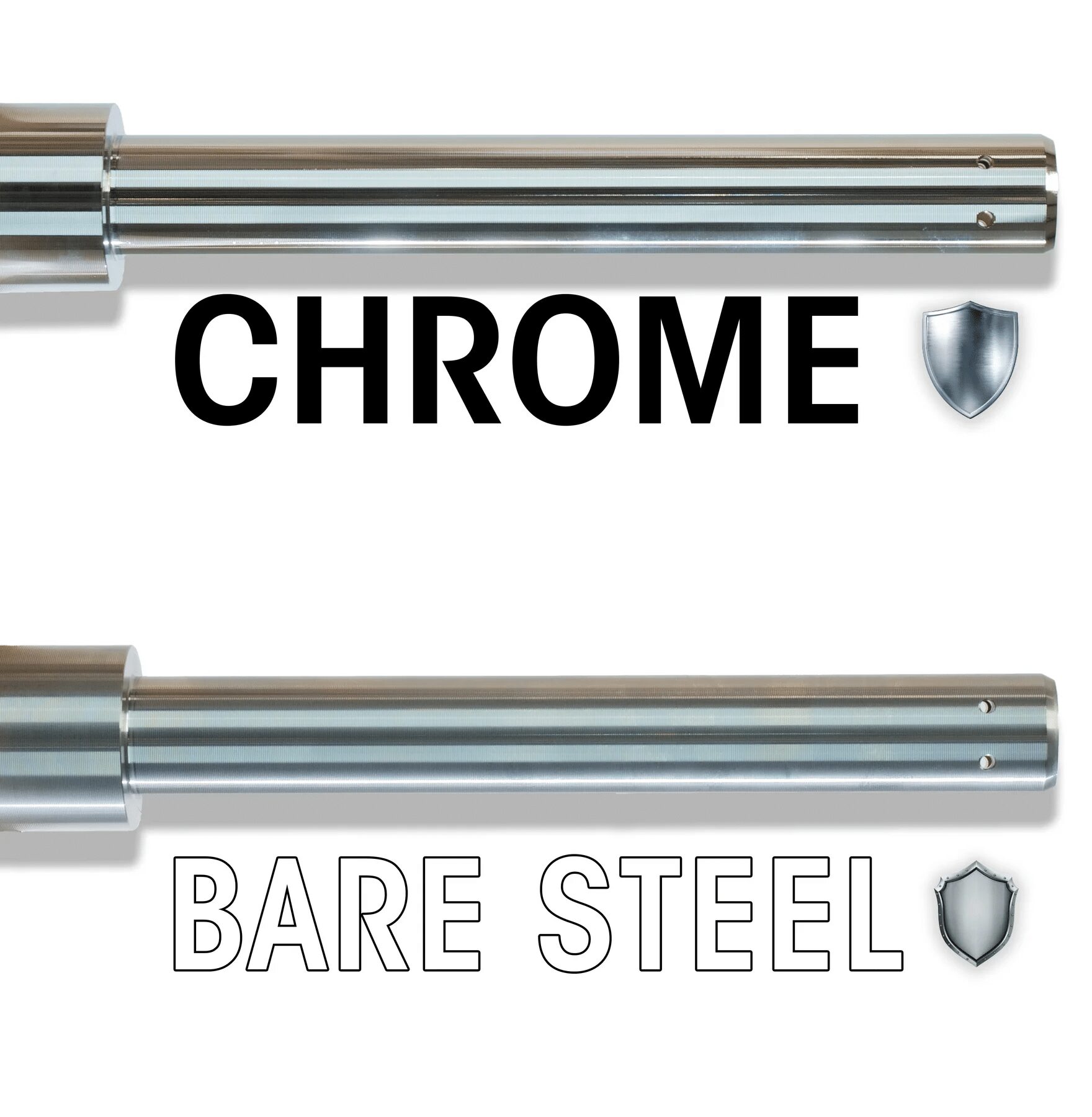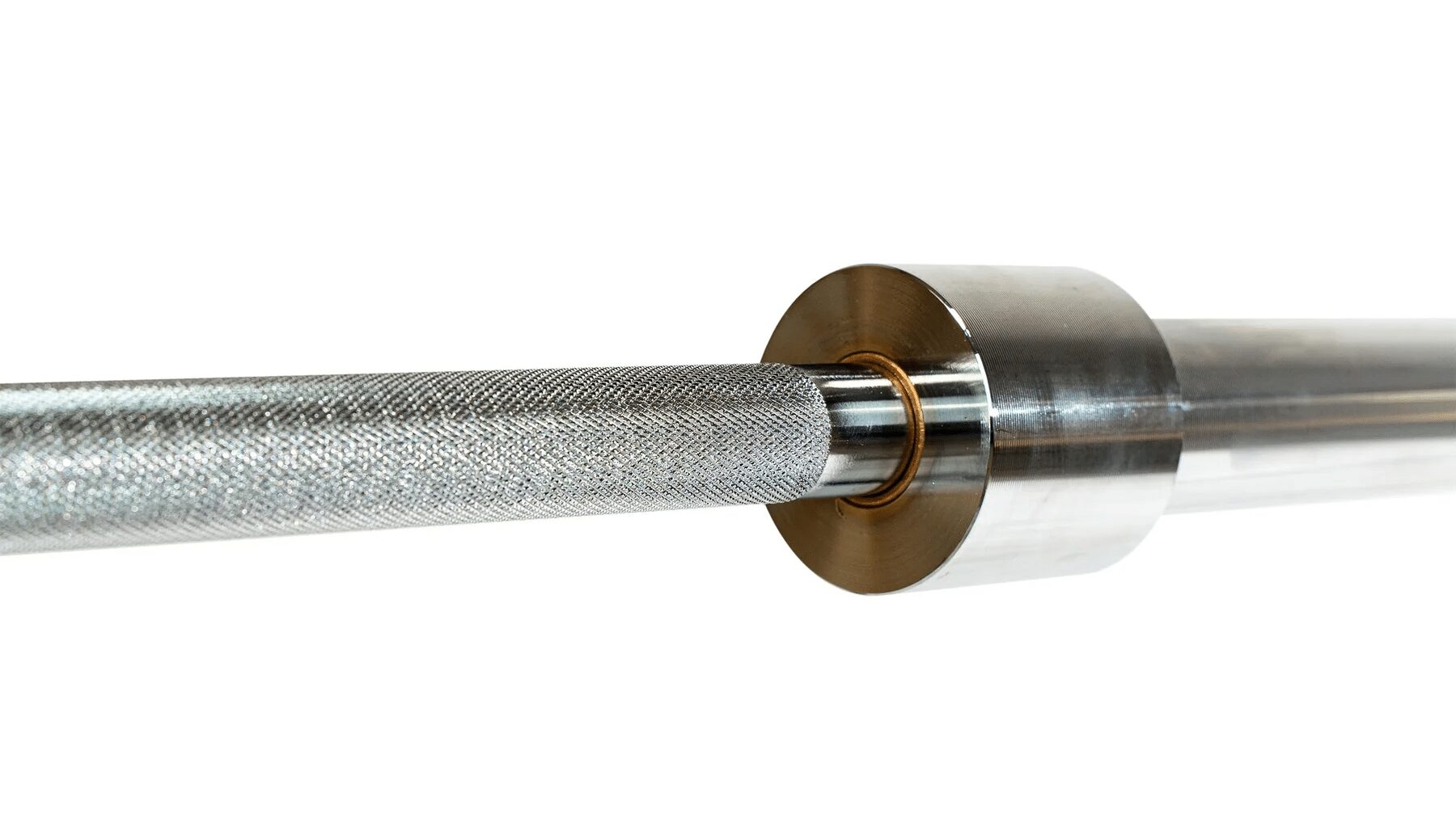Understanding the nuances of various gym equipment is crucial in optimizing your fitness journey.
And if you’re particularly interested in strength training, you might already be aware that choosing the right barbell, especially a deadlift bar, is a significant part of this process.
Deadlifts are an important lift for most lifters, and they can significantly improve your overall strength, muscle mass, and athletic performance.
However, the benefits you reap heavily depend on the type of equipment you use.
In this guide, we will delve into everything you need to know about a deadlift bar, and specifically, we will compare the Rogue Ohio Deadlift Bar and the
On This Page
- What is a Deadlift Bar?
- Differences Between a Deadlift Bar and a Standard Barbell
- Physical Differences Between A Deadlift Bar and A Standard Bar
- Factors to Consider When Buying a Deadlifting Barbell
- Rogue Ohio Deadlift Bar
- Texas Deadlift Bar
- Comparison Of The Rogue Ohio Deadlift Bar vs Texas Deadlift Bar
- Who Should Use A Deadlift Bar?
- What is the Difference Between a Power Bar and an Olympic Bar?
- Frequently Asked Questions
- Conclusion
What is a Deadlift Bar?
A deadlift bar, as the name suggests, is a specialized type of barbell that is designed for performing deadlifts.
They feature a unique design and construction that make them different from standard barbells, and these differences can significantly impact your performance during workouts.
To understand more about these specifics, let’s dive deeper into how a deadlift bar distinguishes itself from a standard barbell.
Differences Between a Deadlift Bar and a Standard Barbell
A common misconception among beginners is that all barbells are the same.
However, a closer look at different types of barbells reveals their unique characteristics.
For instance, an Olympic barbell is different from a standard barbell.
Likewise, a deadlift bar is quite distinctive from a standard barbell.
Standard barbells are versatile and can be used for various exercises, including squats, bench presses, and overhead presses.
They typically have a standard length, thickness, and knurling. A Deadlift bar, on the other hand, is designed with specific modifications to enhance the deadlifting experience.
They are typically longer, thinner, and have more aggressive knurling compared to standard barbells.
Tip: Aggressive knurling provides a better grip, especially when lifting heavy weights. If you’re unsure about what type of knurling your barbell has, check out our guide on Barbell Knurling.
One key feature of a deadlift bar is its “whip” – the ability of the bar to bend or flex under heavy weights.
A good whip allows the weight plates to remain on the ground a little longer as you start pulling, reducing the initial pull off the ground, commonly known as “breaking the floor”.
This whip effect can help you lift more weight by capitalizing on the bar’s momentum as it returns to its straight form.
In essence, using a deadlift bar for your lifts is like using the right tool for the job. It’s specifically engineered for the task, and as a result, it enhances your performance and safety.
RELATED – The Ultimate Deadlift Bar Comparison – Choosing the Right Bar for Your Lifts
Physical Differences Between A Deadlift Bar and A Standard Bar
The Thickness of the Bar
A deadlift bar has a thinner shaft diameter of 27mm compared to a power bar with it’s 29mm diameter.
This reduction in thickness makes the bar easier to grip, which can be a game-changer when you’re lifting heavy weights.
If you’re wondering about the different barbell sizes available and how to choose the right one, take a look at our Barbell Sizes guide.
Distance Between the Sleeves
The distance between the sleeves, or the “loadable sleeve length”, is also a differentiating factor.
A Deadlift bar has longer sleeves, allowing you to load more weight plates.
This feature is especially useful for heavy lifters who need extra space.
Length of the Bar
Deadlift bars are generally longer than standard bars. The extra length not only provides additional whip but also accommodates the longer sleeves.
If you’re interested in understanding more about the significance of bar length, our Barbell Length guide provides more insights.
These physical differences impact the performance of the bars drastically.
For example, a thinner bar with more whip can lead to heavier lifts due to the increased grip and the slight delay in weight pull-off, as explained earlier.
With this understanding of what a deadlift bar is and how it differs from a standard barbell, let’s delve into the key factors you should consider when buying a deadlifting barbell.
Factors to Consider When Buying a Deadlifting Barbell
Before you make a purchase, there are a few key considerations that will determine the best deadlift bar for you.
Tensile Strength and Capacity
Tensile strength refers to the maximum amount of weight a bar can handle without becoming permanently deformed.
A higher tensile strength means a stronger bar.
For most powerlifting federation standards, the bar should have a tensile strength of at least 190,000 psi.
Stiffness/Whip
As we’ve already discussed, the whip of the bar is crucial for deadlifting.
A bar with a good whip can significantly improve your lifts, allowing you to load more weight. You’ll often find that most deadlift bars have a good amount of whip.
Knurling
Knurling is the pattern of diagonal lines cut into the bar that provides grip.
For deadlifting, aggressive knurling is preferred as it provides a better grip and prevents the bar from slipping out of your hands during heavy lifts.
Bar Finish/Feel
Bar finish refers to the type of coating used on the bar.
Different finishes like bare steel, black oxide, or chrome not only affect the look of the bar but also how it feels in your hands and its resistance to rust.
For instance, a raw steel bar may provide a great feel but can rust easily without proper care.
Our comprehensive Barbell Buying Guide can give you more details about these factors.
Armed with these insights, let’s now examine two of the best deadlift bars on the market: the Rogue Ohio Deadlift Bar and the
Rogue Ohio Deadlift Bar
The Rogue Ohio Deadlift Bar is a high-quality, durable, and reliable bar specifically designed for deadlifts.
It adheres to most powerlifting federation standards and is known for its performance, aggressive knurling, and good whip.

Specs
Bar Length – 90.5″
Bar Use – Powerlifting, specifically Deadlifts
Bar Weight – 44.1 lbs. (20 Kg)
Bushing/Bearing – Bushing
Center Knurl – No
IPF Approved – No
Knurling – Aggressive
Loadable Sleeve Length – 15.5″
Made in USA – Yes
Maintenance – Low (although more frequent with the Bare Steel version)
Manufacturer – Rogue Fitness
Max Load – Over 1000 lbs (although max load can depend on many factors such as the type of plates used)
Price Range – $345 – $410
Shaft Coating Options – Bare Steel, Black Zinc, Cerakote, E-Coat
Shaft Diameter – 27mm
Sleeve Finish Options – Chrome, Bare Steel, Bright Zinc, Cerakote
Tensile Strength – 190,000 PSI
Warranty – Lifetime
Whip – Moderate to High

Pros
Cons
Texas Deadlift Bar
The Texas Deadlift Bar is another popular choice among fitness enthusiasts. It’s been a staple in the powerlifting world for decades and is known for its incredible whip and aggressive knurling.

Specs
Manufacturer – Texas Power Bars/Buddy Capps
Purpose – Deadlifting
Bar Weight – 44.1 lbs. (20 Kg)
Tensile Strength – 190,000 PSI
Yield Strength – N/A
Knurl Type – Aggressive
Center Knurl – No
Knurl Marks – Powerlifting
Shaft Finish Options – Bare Steel, Hard Chrome, Black Zinc, Cerakote
Shaft Diameter – 27mm
Sleeve Finish Options – Bare Steel, Chrome
Sleeve Type – Grooved
Rotation System – Bushing
Made in USA – Yes
Warranty – Lifetime
Bar Length – 92.5″
Loadable Sleeve Length – 18″

Pros
Cons
Comparison Of The Rogue Ohio Deadlift Bar vs Texas Deadlift Bar
Both the Rogue Ohio Deadlift Bar and the
However, there are a few key differences between the two bars that could influence your decision.
Similarities and Differences
Both bars have an aggressive knurl for a secure grip and a significant whip that aids in lifting heavier weights.

They both are designed specifically for deadlifting and meet most powerlifting federation standards.
In terms of differences, the Rogue Deadlift Bar has a higher tensile strength than the

The finish on each bar is also different, with the Rogue bar’s bare steel finish requiring more maintenance to prevent rust compared to the Texas bar.
User Preferences and Experiences
User experiences with both bars are generally positive, with users praising their whip and knurling.
Some users prefer the higher tensile strength of the Rogue bar, while others appreciate the Texas bar’s affordability.
The choice between these two bars often comes down to personal preference and budget.
Who Should Use A Deadlift Bar?
A deadlift bar is beneficial for anyone interested in strength training, particularly those who regularly perform deadlifts.
The bar’s design—longer length, aggressive knurling, and whip—makes it ideal for heavy deadlifting.
It can help lift more weight, improve grip, and reduce the risk of injury. It’s particularly popular among powerlifters and those who train in a powerlifting gym.
What is the Difference Between a Power Bar and an Olympic Bar?
When it comes to the difference between a power bar vs an Olympic bar, there are a few key differences to consider.
The power bar is designed for heavy lifting and mainly used in powerlifting competitions.
It is shorter, stiffer, and has more aggressive knurling for better grip.
On the other hand, the Olympic bar is longer and more flexible, suitable for dynamic movements like cleans and snatches in Olympic weightlifting.
Both bars serve different purposes in strength training.
Frequently Asked Questions
Conclusion
Choosing the right deadlift bar can significantly impact your lifting performance.
Both the
Your decision should be based on your personal preferences, lifting needs, and budget.
Remember, the best deadlift bar for you is the one that feels right in your hands, matches your strength goals, and is comfortable for you to use regularly.
Let me know which of these Deadlift bars you’re more interested in below!
Until next time,
-Dante

